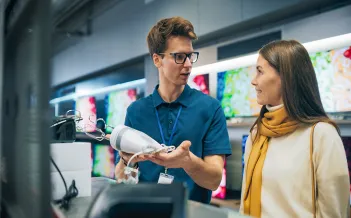Although now an ubiquitous delivery system for education and training at every level, online learning has a relatively short history, as an artifact of the 1980s when computer technology began to hit its inevitable stride.
Now little more than four decades later, millions of learners worldwide have experienced the virtual learning environment in some form, while 98% of American companies report offering online professional development for their employees. What’s more, according to a recent post-pandemic study from Wiley University Services, 94% of the online learners polled said they have a positive or very positive view of this format, with 83% revealing they would choose it again.
So there is no doubt that the virtual education movement will continue to grow and flourish, given the many ways that high-quality, technology-enhanced learning contributes to a sustainable future.
Virtual education and the triple bottom line
At a time in our history when the only constant is change, the concept of sustainability has become more than a buzzword; it’s how organizations of all types create increasing value for both the individuals and the communities they serve. Which is why John Elkington’s “triple bottom line” continues to gain traction as a framework for adding value across three critical realms: social (people), economic (profit or prosperity) and environmental (planet).
And at a time when education for professional development is rapidly becoming a lifelong pursuit, rather than merely a degree-driven activity, there is no doubt that virtual education offers colleges and universities a strategic advantage when it comes to maximizing this three-fold value.
People – Online options empower people of all ages and stages in life to move in and out of the learning environment at anytime from anywhere for any reason to acquire and share valuable knowledge and skills at the speed of need. That said, we are developing a wealth of high-impact technologies to facilitate just-in-time, self-directed learning experiences and collaborative communities of practice.
Profit/Prosperity – By removing the access barriers of time and space, while supporting active, authentic, and customized learning experiences, this approach fuels economic prosperity by preparing an ever more creative and competent global workforce. What’s more, the virtual campus affords institutions a unique opportunity to nurture lifetime learning partnerships with students that generate a steady stream of revenue with which to remain viable.
Planet – Likewise, online learning has proven to significantly lessen higher education’s impact on the environment, by greatly reducing carbon emissions and energy consumption – an estimated 85% and 90% respectively, according to the Open University of Britain. And that’s a huge plus given some 20 million students are currently enrolled on campuses across the country, in addition to the growing number of workers seeking training options for reskilling and upskilling.
Of course, while virtual education does in fact operate within Elkington’s sustainability framework, it must continue to meet the evolving needs of a changing world and a changing workforce. That will mean continually exploring new and increasingly more effective ways to design and support high-quality, technology-enhanced, learner-centric educational experiences and environments.
The hallmarks of quality
When it comes to providing first-rate virtual education, And given the ever-expanding digital toolbox at our disposal, we can create virtual options grounded in proven principles for successful learning, by incorporating the following hallmarks of quality design.
It provides ample opportunities for experiential learning
In the words of Albert Einstein “Learning is experience. Everything else is information.”
That’s why experiential learning – learning by doing – engenders higher rates of knowledge acquisition and skills mastery, by turning learners into active rather than passive participants in the learning process. To be sure, this form of immersive education has long been provided in the form of in-person clinical rotations and practicums, internships and apprenticeships. But online education offers an exceptional canvas for designing high-impact learning experiences, grounded in deliberate, hands-on practice within an authentic virtual learning environment.
For example, EdTech companies such as Hurix Digital are using interactive tools like augmented and virtual reality, to create wholly engaging, immersive learning environments, customized to meet workforce-specific training needs across a variety of industries.
These gamified virtual learning solutions empower learners to connect remotely and safely with real-world scenarios to acquire, apply, and master requisite knowledge and skills. And rooted in best practices for adult learners, they facilitate iterative practice with immediate feedback that enables learners to connect the dots between what they know and what they need to learn. It is competency-focused.
Of course, experiential learning goes hand-in-hand with competency-focused learning when it comes to acquiring and retaining expert knowledge and complex skills. Traditionally, learning outcomes have been grounded in memorizing information with the goal of passing written tests. But competency-based virtual education supports the concept of deep understanding, demonstrated through skills mastery and application, using a variety of accessible technologies.
Under this scenario, learning outcomes are proven by action, and focus on building career-relevant skills that enable students to succeed in their chosen fields. Likewise, competency-based virtual education is tailored to meet different learning preferences and abilities. It is also structured to assess the learner’s ability to integrate and apply their learning within the context of the ever-evolving challenges they will likely face in their work life. And while hard skills are important, soft skills – such as communication and creativity, collaboration and adaptability – are as, if not more, essential, according to the vast majority of employers these days.
With that goal in mind, high-quality, competency-based virtual education should incorporate clearly articulated learning objectives, using action verbs to describe desired performance indicators for measuring both industry- and discipline-specific competencies. It should also offer multiple modalities with which to demonstrate both hard and soft skills mastery. That means providing a choice among written and video, audio and graphic assessments, as learners build a readily accessible e-portfolio for future reference.
For example, every semester the Berklee School of Music engages the Budapest Orchestra to play and record their Film Scoring Master’s Degree students’ original compositions while they witness the entire performance online. These sessions are also recorded as videos for students to include in their own professional portfolios.
It empowers learners to connect and collaborate on any device
Cognitive science has long held that we learn most effectively when we have plenty of opportunities for connecting and collaborating with others. To be sure, this approach enables learners to cultivate and experience the benefits of collective intelligence and ongoing feedback within peer-supported learning environments. And given today’s high-touch technologies, we can provide virtual connectivity on-demand and on any device, for sharing content, resources, and insight around a given topic or interest – often beyond the classroom and well into the future.
Indeed, EdTech companies are creating online platforms that not only facilitate connectivity, but also afford additional perks beyond the traditional online discussion board. Yellowdig has developed one such student-driven, community-building platform with an integrated assessment tool that awards points for engagement, through posting and commenting.
Having been adopted by such institutions as Northwestern University and Babson College across a variety of disciplines, this plug and play platform is garnering kudos from students and instructors alike, as a user-friendly tool for connecting and collaborating around any topic. In fact, instructors report higher rates of interaction and deeper levels of discussion that exposed a broader range of perspectives – all benchmarks of effective learning experiences.
Handpicked Related Content
Using Remote Patient Monitoring to Improve Cardiac Care: A 9-Point Checklist
It supports personalized engagement
While the “one size fits all,” instructor-led model of rote learning has afforded educators a reliable structure within which to teach, it falls short of engaging students in effective learning, grounded in individual preferences and abilities, professional needs and interests. That’s where personalized learning hits the mark.
Although the concept of personalized learning is far from new, technology is taking it to far greater heights, thanks to EdTech providers like Firstsource. Using artificial intelligence, analytics and machine learning, this company is developing digital platforms that drive scalability, while supporting a personalized student learning experience.
As such, these platforms put learners in full control of their learning process – its sequence, pace and flow; format, content and assessment. In fact, study after study shows that we are best served when allowed to exercise greater voice and choice in what we learn, as well as when and how we learn it. That said, when thoughtfully designed to effectively integrate the latest smart technologies, online education makes it possible to accommodate the diverse learning needs and preferences of our students and employees – regardless of age, ability and experience.
To summarize…
As the pandemic so clearly revealed, virtual education offers a sustainable strategy – within Elkington’s triple bottom line framework – for exploiting the power of technology to ensure the promise of readily accessible lifelong education and training in an age of constant change.
But as we also learned, it takes more than a videoconferencing platform to deliver first-rate, research-informed online learning options – both in our schools and in our workplaces. Options that, in fact, greatly improve upon the traditional in-person learning experience, with its one-size fits all, talk and test instructional model.
And with the help of innovative EdTech companies like Firstsource, Hurix Digital, and Yellowdig we can accomplish that objective in a way that benefits everyone – from our institutions and their students, to our workforce, to society as a whole.
This article is written by Dr. Susan C. Aldridge who is the Interim President of Thomas Jefferson University and previously served as President of Drexel University Online. Dr. Aldridge is a recognized higher education leader, strategist, and futurist, who has held executive leadership positions in some of the country’s largest universities.










